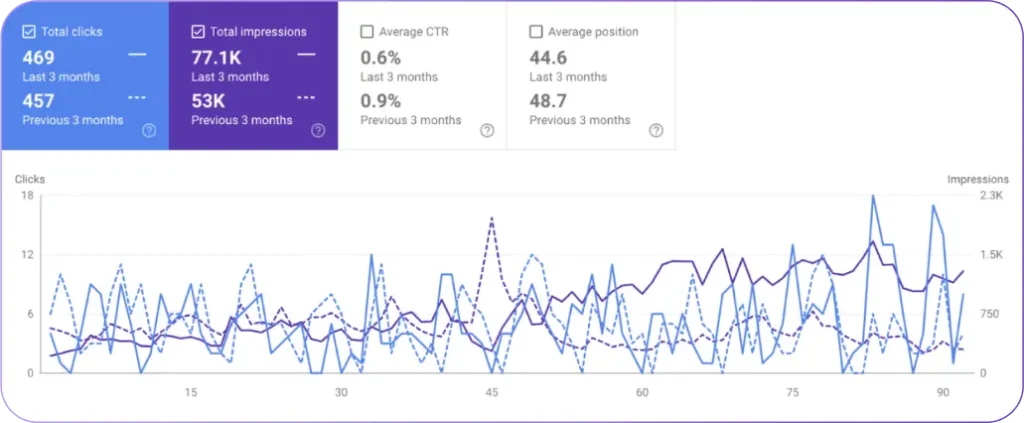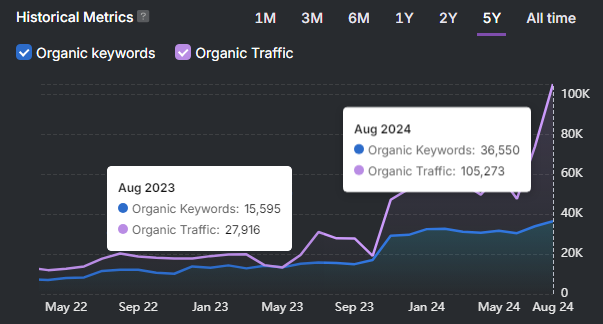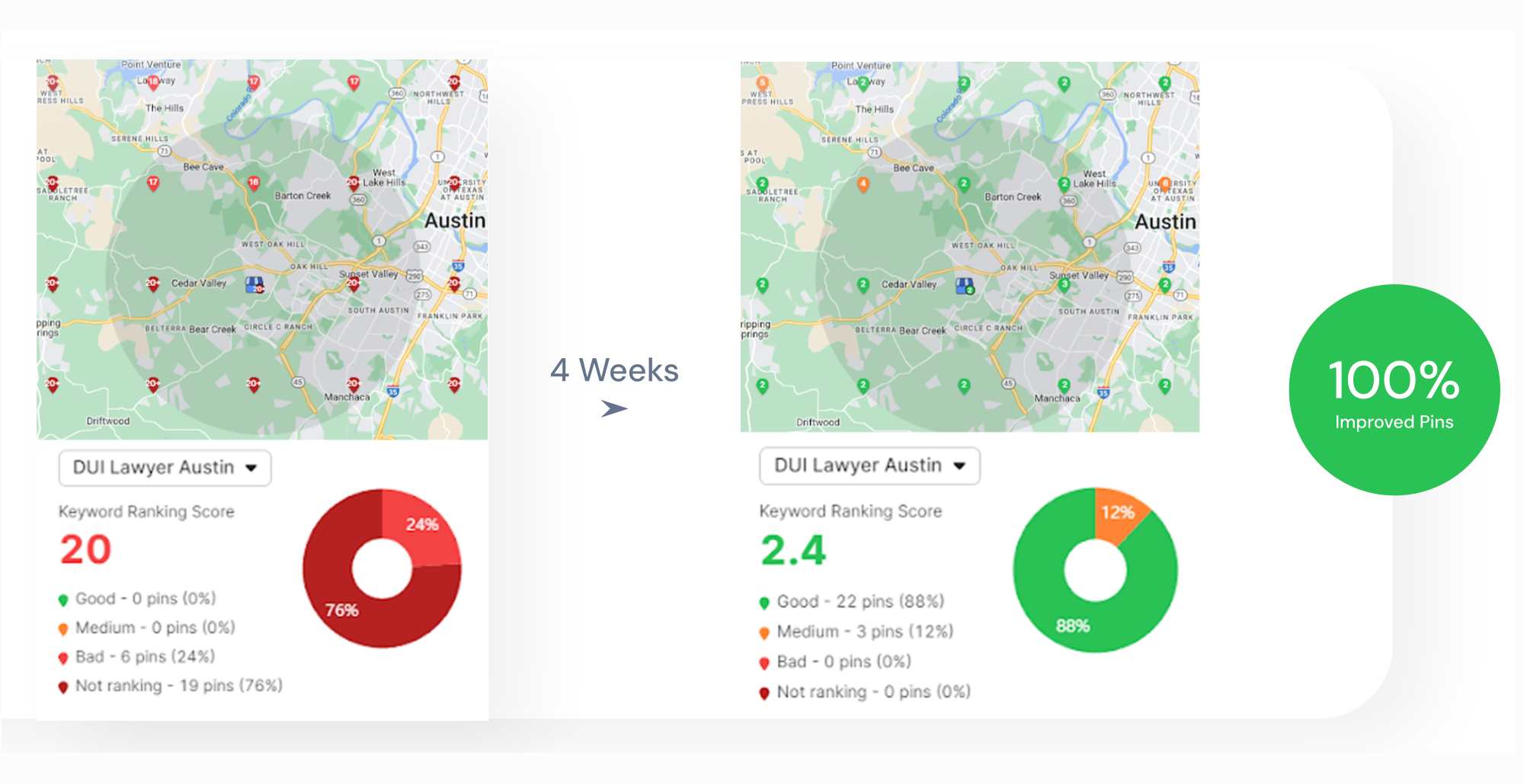Looking to find trending keywords for SEO and digital marketing? Creating content is more effective when backed by research, especially SEO-focused keyword research. The key here is finding trending keywords before big websites with large budgets dominate the search results.
That’s why you need to use effective strategies for discovering trending topics and keyword research tools that offer data-driven insights. We explain what trending keywords are, their benefits and types, and how to find and use them.
What Are Trending Keywords?
Trending keywords are search terms that are gaining popularity right now. Trending keywords reflect current interests or events. Marketers use them to create timely content that boosts website visibility and ranking. For example, terms like “Super Bowl 2025,” “remote work opportunities,” or “new tech gadgets” are trending topics. 📈
In SEO, trending keywords usually don’t have much search history, so tools show them with low or zero volume. In reality, trending keywords have strong traffic potential.

What Are the Benefits of Keyword Trends?
Top SEO experts and content marketers know that finding trending keywords is a smart use of their time. These keywords connect your content to what people are actively searching for, making it a strong SEO strategy with significant benefits. Common benefits of keyword trends are listed below.
- First-mover Advantage. Keywords that are just emerging let you jump ahead of the competition and be an early voice in the conversation.
- Better Rankings. Content focused on trending keywords often ranks higher on Google and other search engines than more competitive terms.
- Stronger Brand Perception. Trends show your brand is in tune with what matters to your audience, which boosts your authority.
Pro tip. Updating your keyword strategy regularly is key as trends change quickly.
10 Top Strategies and Tools for Discovering Trending Keywords
We cover 10 top strategies and techniques to help you discover the best trending keywords and topics for SEO blogging and other goals.
1. Keyword Research Tools for Great Opportunities
Keyword research tools are the primary way for discovering trending keywords because they are fast, data-driven, and reliable. Keyword research tools give you valuable insights into search volume, keyword difficulty, potential traffic, and related terms. The Historical Search Volume data in research tools shows how search volume for terms changes over time.
For example, a keyword like “best gaming chair 2025” is rising as new models are released.
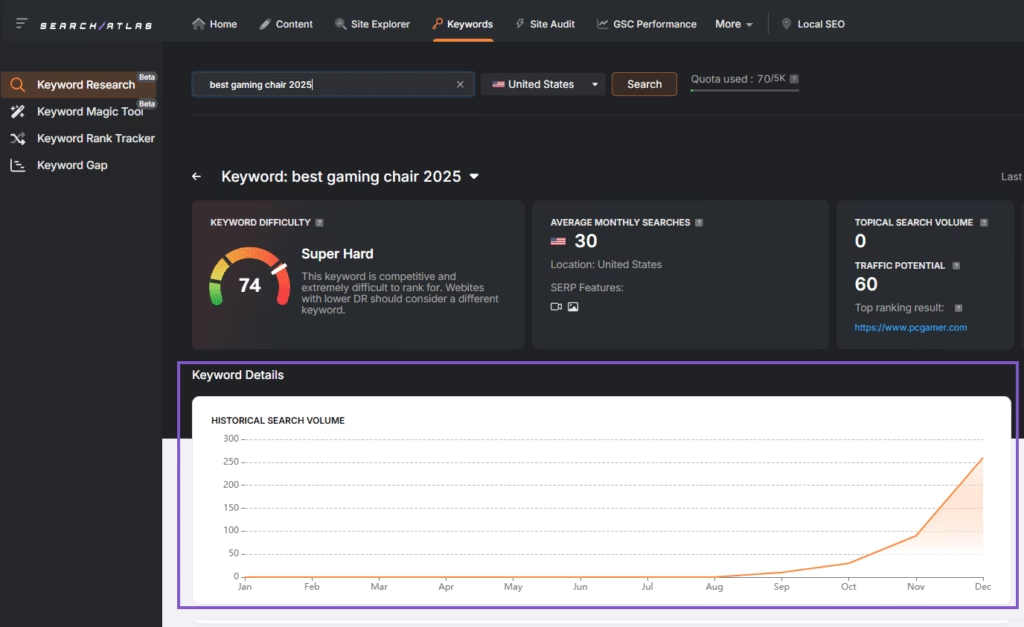
On the other hand, “iPhone 15 review” declined as interest shifted to newer models.
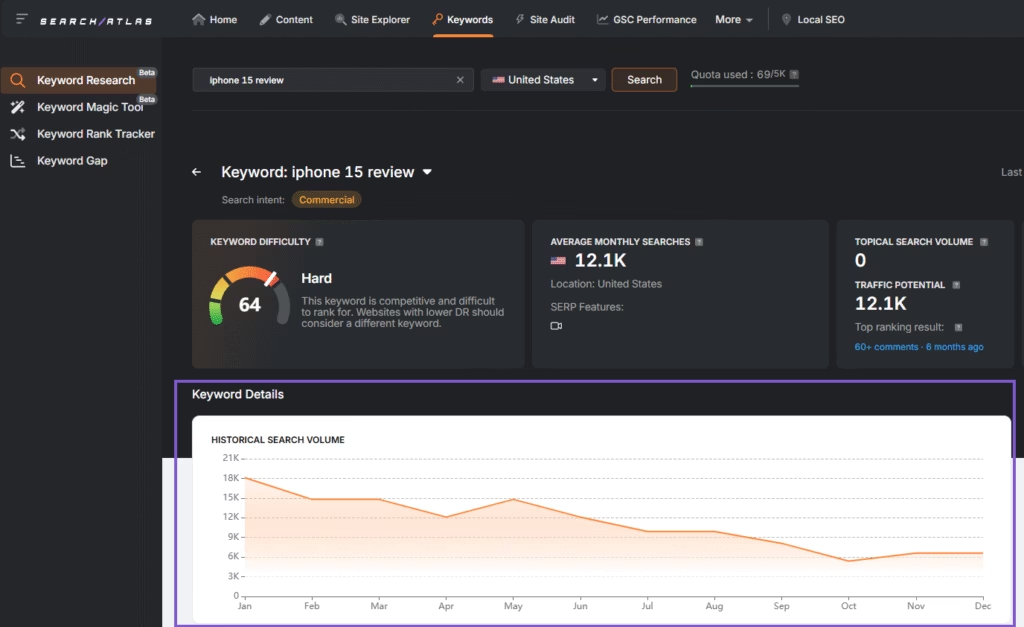
Monitoring these trends helps you target emerging topics and avoid outdated ones, which keeps your content fresh and competitive.
2. Use Google Keyword Planner for Trending Keywords
Google Keyword Planner is a free tool that helps you discover trending keywords, search volume, and competition levels. You need a Google Ads account in Expert Mode to access Google Keyword Planner, but once inside, it lets you explore keyword ideas, track monthly search trends, and analyze cost-per-click (CPC) data.
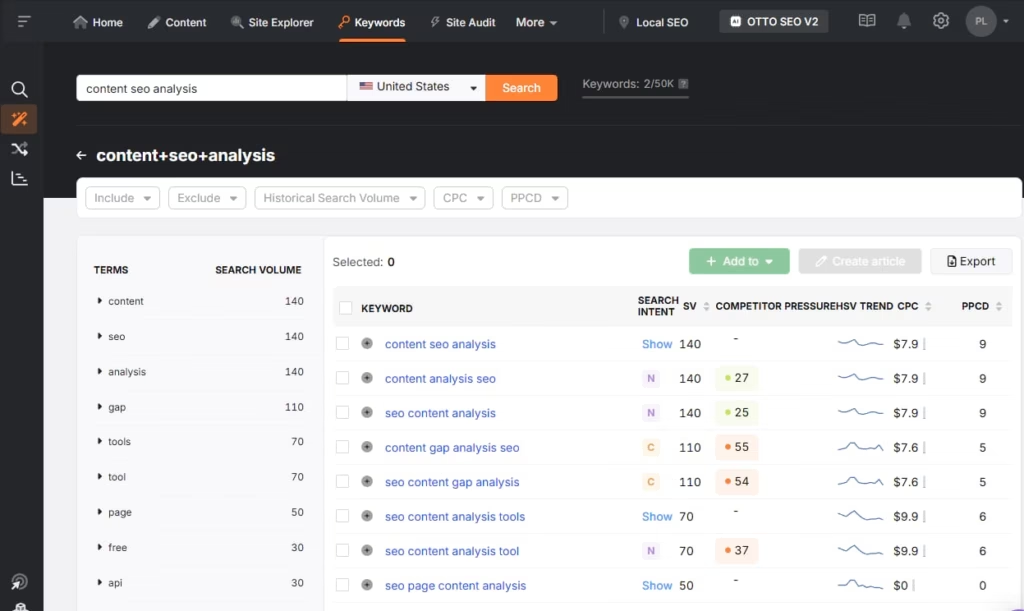
Tracking keyword trends over time is a highly useful feature of Google Keyword Planner. For example, a spike in searches for the keyword “mortgage brokers” signals a growing interest. It’s possible to sort keywords by competition and CPC to find profitable opportunities.
Keyword research tools like the Keyword Magic Tool provide even more refined Google PPC data. The Keyword Magic Tool helps you spot trends early and optimize your strategy.
3. Visit and Read Q&A Sites to Find What People Are Discussing
Q&A sites like Reddit and Quora are a goldmine for spotting trending keywords and real-time discussions if your audience is active on there. The topics people talk about on Q&A sites often reflect what they’re searching for on Google.
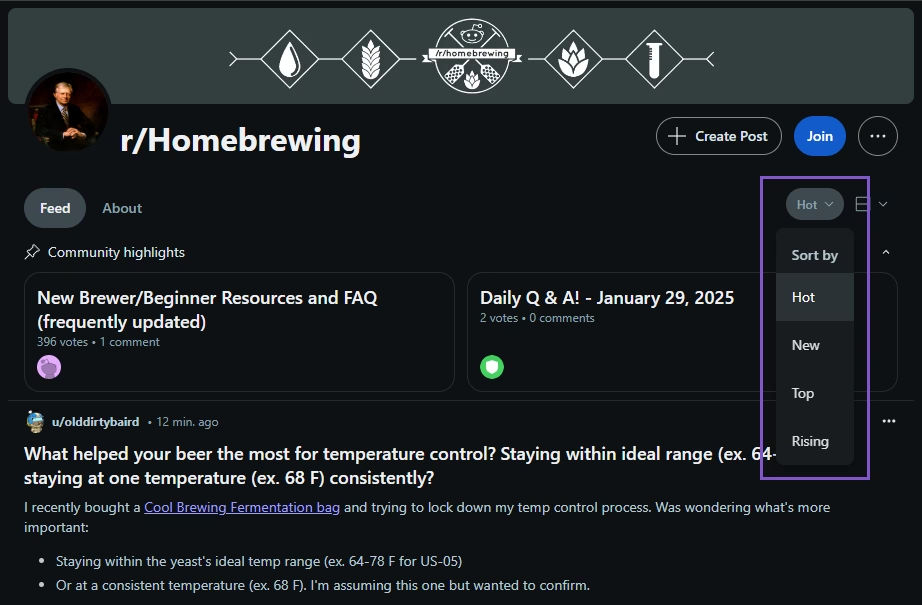
Start by searching for a broad term in your niche. Let’s say “home brewing.” You find subreddits like r/Homebrewing and r/Brewing, where users discuss everything from equipment recommendations to fermentation tips.
Sorting posts by “hot,” “top,” or “rising” highlights emerging trends. For example, a spike in discussions about “beginner-friendly beer kits” or “low-alcohol craft brews” points to potentially growing topics worth covering in your content.
4. Use Forums to Find Emerging Topics
Beyond Reddit and Quora, niche forums and boards provide valuable insights into what people are actively discussing. Google even has a dedicated “Forums” tab to help you find these conversations faster.

A forum buzzing about “how to get leads for my skate shop” points to real business owners discussing their challenges and ideas. These organic discussions reveal not just rising topics but why people care about them. On the flip side, a decline in conversations potentially indicates fading interest.
Pro tip. Spot recurring questions and emerging trends before they peak by filtering for recent discussions.
5. Monitor Industry News and Updates
Keeping up with industry news is one of the best ways to spot trending keywords early. News, pop culture, and major events drive tons of Google searches, so staying informed helps you tap into emerging topics before they peak.
Follow blogs, subscribe to newsletters, and keep an eye on industry updates. For example, people are likely searching for terms like “eco-friendly shipping materials” or “biodegradable mailers” if sustainable packaging is making headlines.
Think like your audience. What news affects them? Staying ahead keeps your content fresh and relevant, whether it’s a new tech breakthrough or an economic shift.
6. Use Google Trends to Find Hot Topics
Google Trends is a great way to spot trending keywords before they explode. Google Trends shows search interest over time, which lets you see what’s gaining momentum and what’s fading.
Enter a keyword to get a chart of its popularity. Filter by location, category, and time range to find trends relevant to your niche. To discover seasonal keywords, adjust the date range. For example, the keyword “best winter jackets” spikes every December.
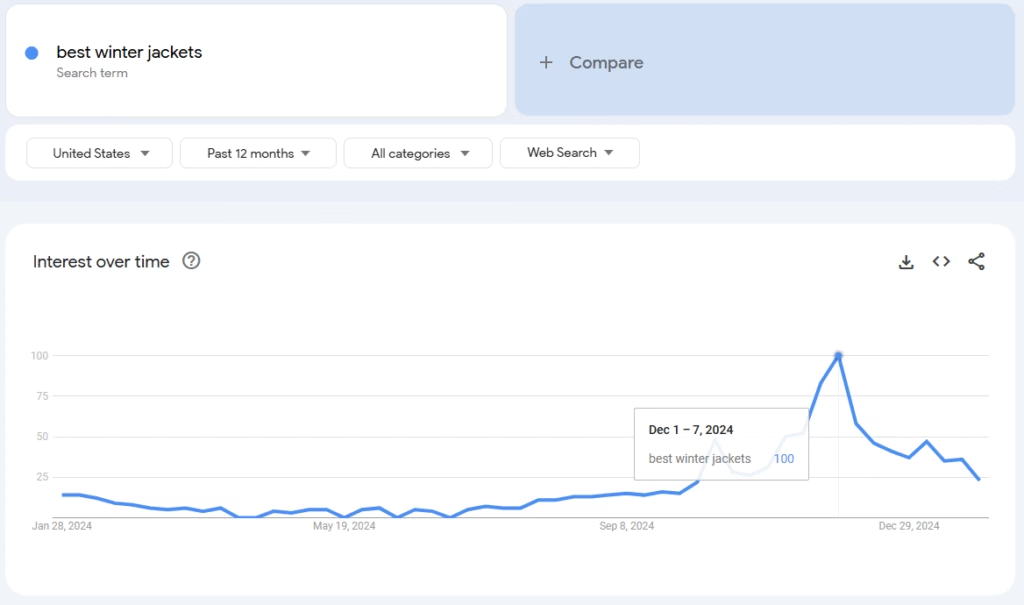
To see where a search term is most popular, scroll down to the interest by region section. The interest by region section highlights which states or cities are searching for your keyword the most.
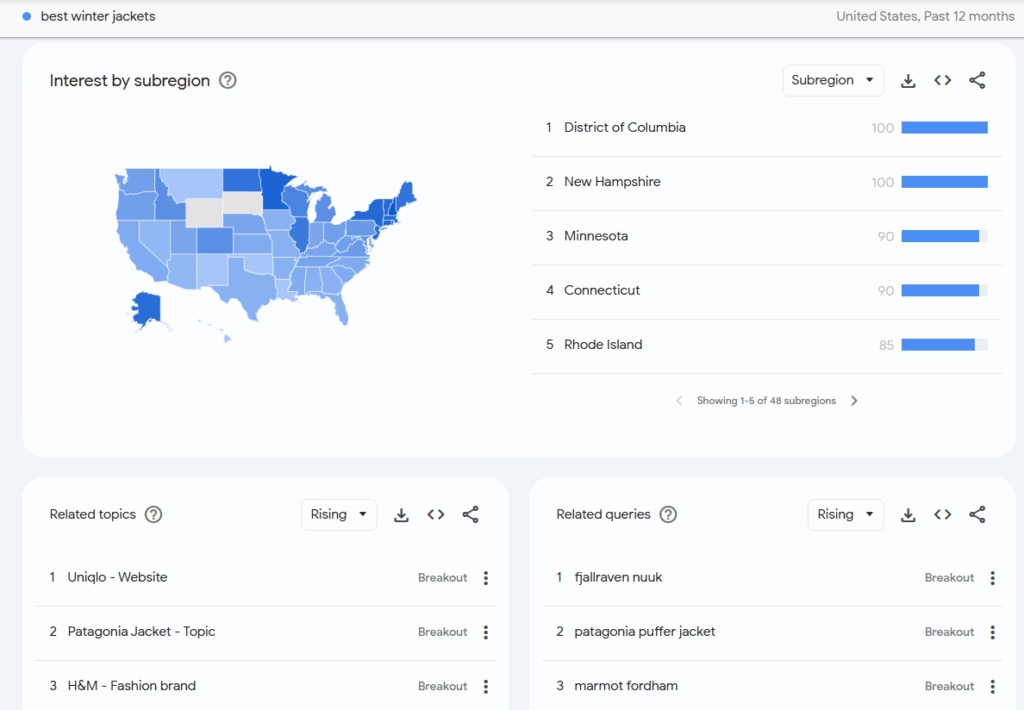
Regional keyword trends are perfect for tailoring local SEO strategies. One of the most useful features is “Related queries,” which highlights fast-growing searches connected to your keyword. Google Trends puts them in 3 categories which are listed below.
- Top Queries. The most searched terms related to your topic.
- Rising Queries. Keywords with the biggest recent increase in search volume.
- Breakout Queries. Searches that have skyrocketed by over 5,000%. These are the hottest trends to catch early.
Monitor these 3 types to stay ahead of search trends and create content before your competitors do.
7. Monitor Social Media for Real-Time Topics and Trends
By tracking popular hashtags and discussions, you get a real-time look at what’s capturing the attention of your audience. Platforms like Twitter, Instagram, TikTok, and even YouTube are especially helpful for this. For example, trending location-specific hashtags make your content more relevant to regional audiences.
The “Trending” section on platforms like X (formerly Twitter) shows growing interest. Instagram has a “tags” section that lets you explore popular terms. On TikTok, the Creative Center provides insights into trending hashtags. Use the keywords you find for content ideas or refine them for SEO. Check the keyword volume and difficulty before deciding if it’s worth targeting.
8. Run Competitor Analysis to See What Your Competition Is Doing Right Now
Understand what your competitors are doing well and tweak your own strategy to stay ahead. Start by checking out competitor websites and blogs to see which keywords are driving traffic and engagement.
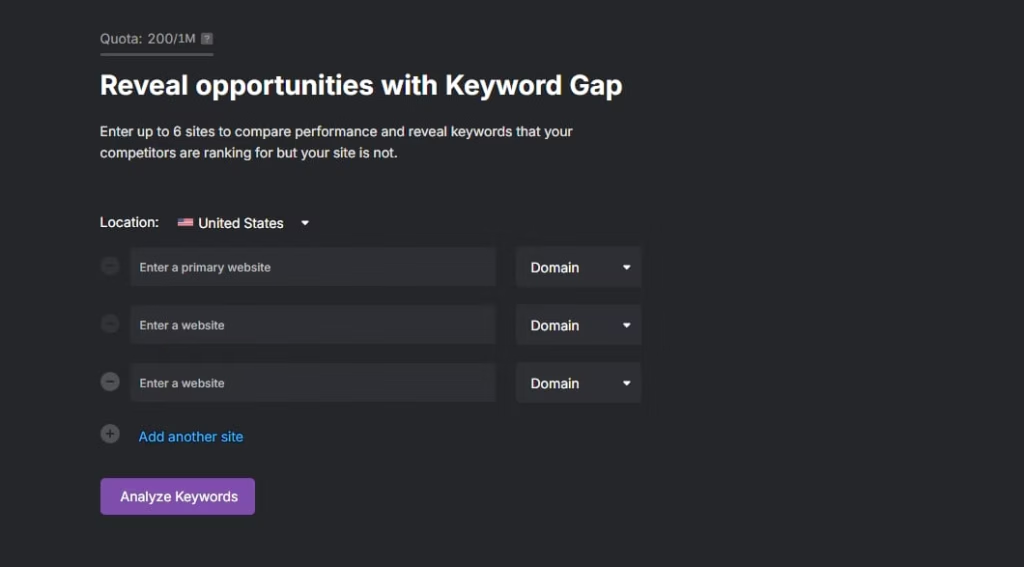
Use tools like Keyword Gap to dive deeper into competitor keyword performance. These tools offer keyword gap analysis, which highlights the terms your competitors rank for that you don’t. Keyword gap analysis helps you discover new opportunities. Consistently track what these keywords are to stay on top of trends and make adjustments to your SEO strategy.
9. Analyze the SERPs to Understand How Top Pages Are Changing
Observe features like featured snippets, knowledge panels, and “People Also Ask” to see how information is being presented and what questions users have. These insights help you tailor your content to what people are searching for. Tracking how the SERPs change over time is crucial to spot shifts in trending searches and adjust your strategy.
The SERPs change in various ways that reveal evolving trends and user behavior. Examples of changes to track are listed below.
- Featured Snippets. A keyword that used to show regular organic results suddenly starts appearing in a featured snippet box, often ranking at the top of the page. This indicates that users are looking for quick, concise answers to their queries.
- Knowledge Panels. The appearance of a knowledge panel for a topic suggests that there’s growing interest or importance around that subject.
- People Also Ask (PAA). The “People Also Ask” box evolves as new questions or concerns emerge. A search term that begins showing multiple follow-up questions signals that more people are curious about various aspects of the topic. Use People Also Ask tools to discover keyword trends.
- Seasonal Trends. Let’s say you’re tracking the keyword “best beach resorts.” Pages that rank at the top in summer tend to drop down in fall.
- Algorithm Updates. Algorithm updates change the SERPs as they shift the way they approach ranking factors.
- Content Refresh. Outdated content loses its position if competitors refresh their content or add more valuable information. Prevent content decay to stay relevant.
- User Intent Shifts. Top-ranking pages change based on shifts in user intent. For example, video content replaces text guides in the SERPs after users show they prefer video.
10. Track Content Performance to Know What’s Really Trending
Tracking how your content performs with trending keywords helps you see what’s working, what’s not, and what’s gaining traction. To make your life easier, use a tool that integrates with both Google Search Console (GSC), Google Analytics (GA4), and keyword rank tracker (KRT) to monitor keyword performance.
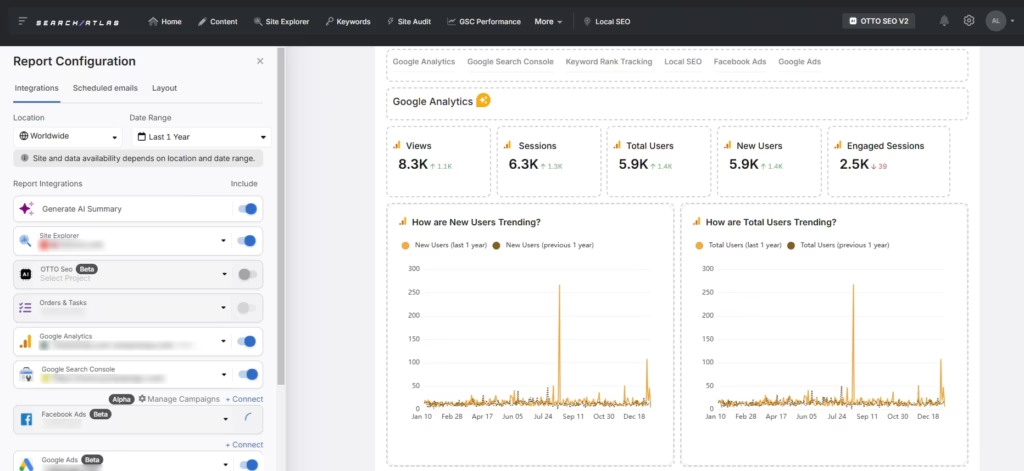
Using these tools together in a single report gives you a clear picture of how your content is performing and if your keywords are still hitting the mark.
How to Use Keyword Trends as Part of Dynamic SEO
Use keyword trends as a part of a dynamic SEO strategy. Dynamic SEO adapts optimization strategies based on real-time user intent and search trends, contrasting with traditional periodic manual adjustments. Search engine algorithms change frequently, requiring continuous monitoring and automatic optimization rather than quarterly reviews.
Dynamic SEO is the basis for Search Atlas AI tools. These tools use automation to track algorithm changes and apply modifications as they occur. This maintains search visibility in spite of algorithmic updates or shifting user behavior patterns.
OTTO SEO
OTTO SEO is a part of the AI SEO platform Search Atlas. OTTO SEO tracks keyword trends continuously, analyzing search volume changes, emerging queries, and ranking fluctuations following Google updates. OTTO SEO identifies new keyword opportunities by examining user intent shifts and industry topic emergence. The tool adjusts optimization strategies automatically without manual intervention.
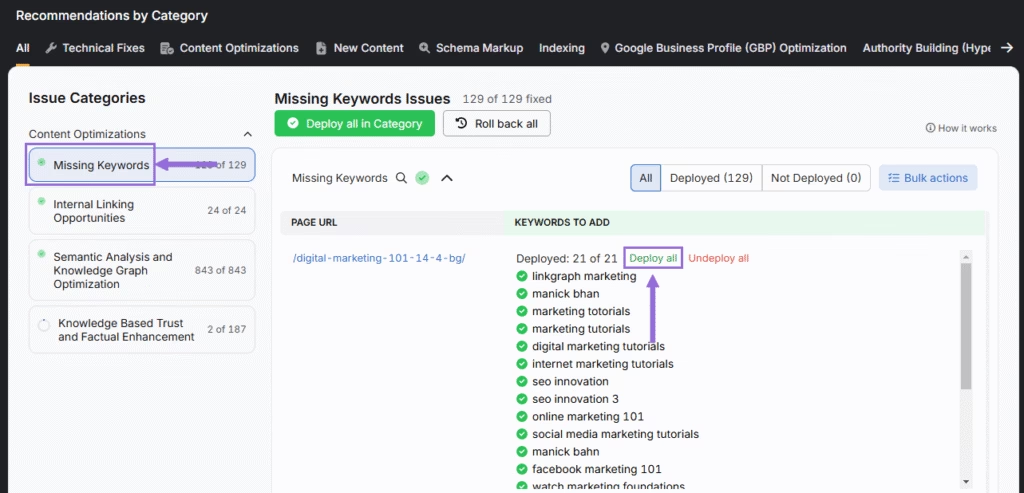
A restaurant equipment supplier used the Search Atlas AI SEO assistant to target relevant keywords and create industry-specific content. AI-driven keyword suggestions and automated content creation produced optimized material that attracted their target audience. This approach increased organic keywords by 40% and improved audience targeting.
OTTO Google Ads
OTTO Google Ads analyzes website content to create Google Ads campaigns using keyword trend data. The system selects keywords based on current performance metrics and search pattern analysis, organizing ad groups and generating ad copy aligned with identified opportunities. OTTO Google ads monitors keyword performance continuously, adjusting bids and pausing underperforming terms based on real-time data. Campaign modifications occur automatically.
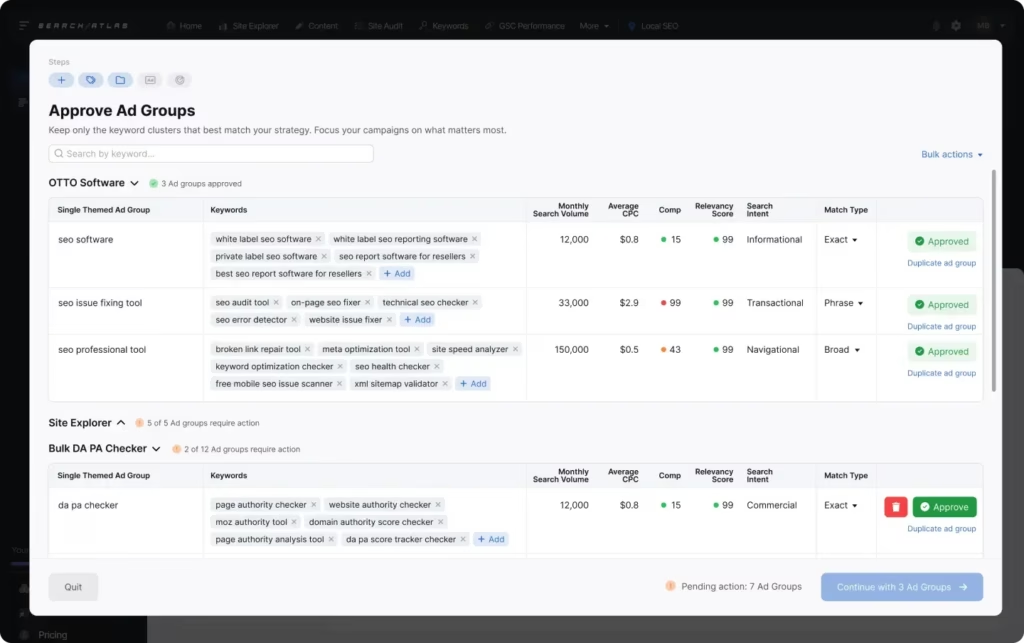
Use AI to Keep Up With Updates and Industry Shifts
Trends shift fast, and Google updates reshuffle the SERPs just when you reach your goals. But you don’t have to keep up with it all manually. Meet OTTO, the first AI SEO agent that automates almost every part of SEO, including keyword updates, technical fixes, on-page optimization, content creation, and more.
Integrate your Google Search Console (GSC) and Google Business Profile (GBP). The moment Google or user behavior shifts, OTTO identifies new keyword opportunities and instantly updates your content or creates fresh pages. OTTO actually implements changes unlike other AI tools that just suggest them. 😎
Plus, Search Atlas provides everything else for a complete SEO strategy—keyword research, backlinks, competitor analysis, site audits, and more. Try an OTTO free trial today!








